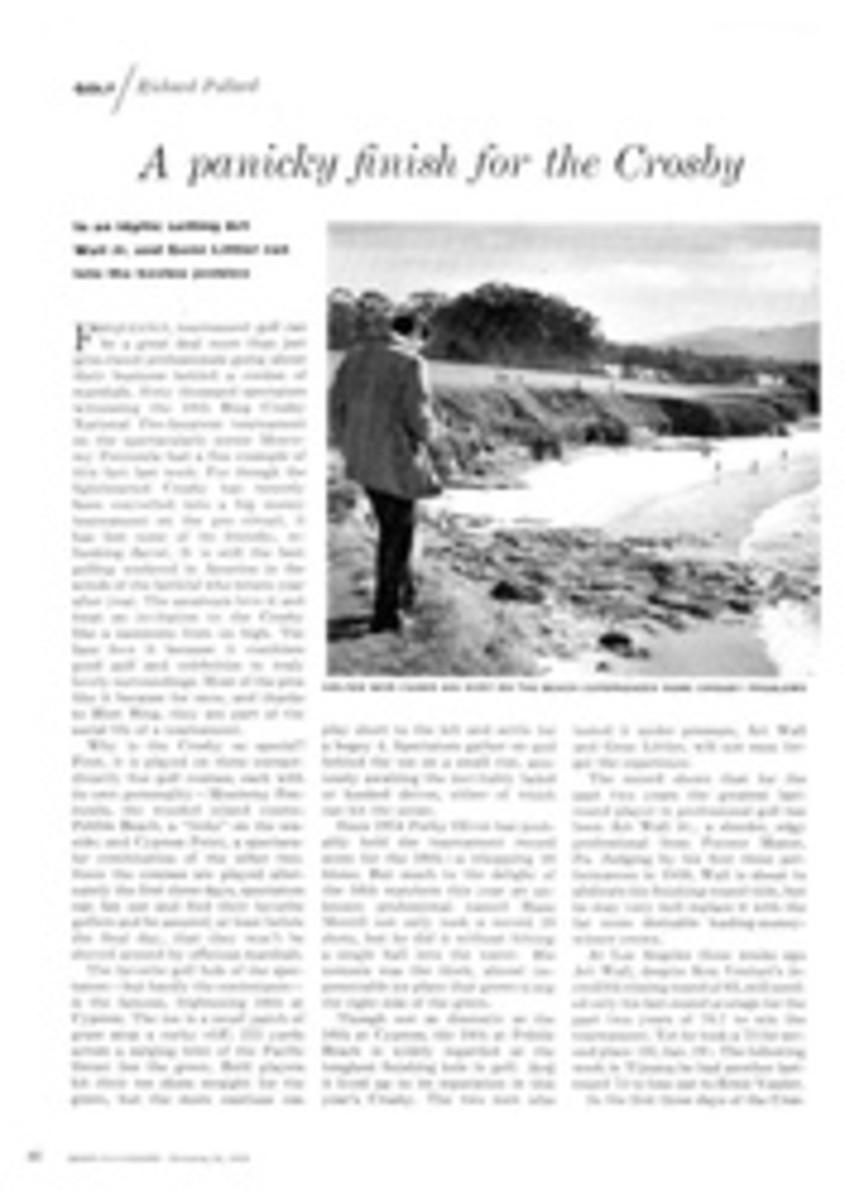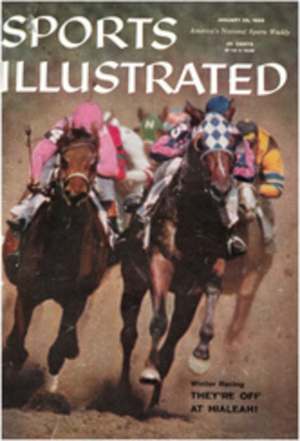
A panicky finish for the Crosby
Frequently, tournament golf can be a great deal more than just grim-faced professionals going about their business behind a cordon of marshals. Sixty thousand spectators witnessing the 18th Bing Crosby National Pro-Amateur tournament on the spectacularly scenic Monterey Peninsula had a fine example of this fact last week. For though the lighthearted Crosby has recently been converted into a big money tournament on the pro circuit, it has lost none of its friendly, refreshing flavor. It is still the best golfing weekend in America in the minds of the faithful who return year after year. The amateurs love it and treat an invitation to the Crosby like a summons from on high. The fans love it because it combines good golf and celebrities in truly lovely surroundings. Most of the pros like it because for once, and thanks to Host Bing, they are part of the social life of a tournament.
Why is the Crosby so special? First, it is played on three extraordinarily fine golf courses, each with its own personality—Monterey Peninsula, the wooded inland course; Pebble Beach, a "links" on the seaside; and Cypress Point, a spectacular combination of the other two. Since the courses are played alternately the first three days, spectators can fan out and find their favorite golfers and be assured, at least before the final day, that they won't be shoved around by officious marshals.
The favorite golf hole of the spectators—but hardly the contestants-is the famous, frightening 16th at Cypress. The tee is a small patch of grass atop a rocky cliff; 222 yards across a surging inlet of the Pacific Ocean lies the green. Bold players hit their tee shots straight for the green, but the more cautious can play short to the left and settle for a bogey 4. Spectators gather on and behind the tee on a small rise, anxiously awaiting the inevitably faded or hooked drives, either of which can hit the ocean.
Since 1954 Porky Oliver has probably held the tournament record score for the 16th—a whopping 16 blows. But much to the delight of the 16th watchers this year an unknown professional named Hans Merrill not ~only took a record 19 shots, but he did it without hitting a single ball into the water. His nemesis was the thick, almost impenetrable ice plant that grows along the right side of the green.
Though not as dramatic as the 16th at Cypress, the 18th at Pebble Beach is widely regarded as the toughest finishing hole in golf. And it lived up to its reputation in this year's Crosby. The two men who tested it under pressure, Art Wall and Gene Littler, will not soon forget the experience.
The record shows that for the past two years the greatest last-round player in professional golf has been Art Wall Jr., a slender, edgy professional from Pocono Manor, Pa. Judging by his first three performances in 1959, Wall is about to abdicate his finishing-round title, but he may very well replace it with the far more desirable leading-money-winner crown.
At Los Angeles three weeks ago Art Wall, despite Ken Venturi's incredible closing round of 63, still needed only his last-round average for the past two years of 70.7 to win the tournament. Yet he took a 73 for second place (SI, Jan. 19). The following week in Tijuana he had another last-round 73 to lose out to Ernie Vossler.
In the first three days of the Crosby, Wall put together a 69 at Cypress, a 65 at Monterey Peninsula and a 2-under-par 70 at Pebble Beach. This left him 4 strokes up on Jimmy Demaret and 6 ahead of former U.S. Amateur Champion Gene Littler. On the basis of his once-formidable last-round penchant, everyone felt Wall was a shoo-in.
Wall's start on Sunday morning confirmed this. He quickly birdied the first three holes with putts of 35, 5 and 10 feet. At this point, the Pebble Beach course turns to the ocean, and all manner of troubles pop up. Nonetheless, Wall managed to turn in a creditable 2 under par on the first nine. Another birdie on No. 10 put him 9 strokes up on Littler. But that was his last good hole. He bogeyed No. 11, double-bogeyed No. 12, bogeyed 13 and 14, birdied 15 and bogeyed 16 and 17 to lose 8 full strokes to Littler.
Going into the 18th, Wall's lead had dwindled to one stroke, and there wasn't a soul in the huge gallery who didn't feel a sickness in his stomach over the collapse of this fine golfer. Littler as always was ice-calm.
Both men drove well, but Littler's ball hooked close to the edge of the sea wall that protects the 18th fairway from the lapping waves of Carmel Bay. Wall played his second wood safely down the middle, and Littler took out a four-wood to insure a safe shot from a difficult lie. He took three easy practice swings, then hit a looping hook well out into the bay. It cost him a two-stroke penalty, and by the time Littler's alternate ball reached the green he lay 5. Wall, meanwhile, had a seven-iron approach into the trap in front of the green, and he came out too strong to the back edge of the undulating green but still on the putting surface. Two putts put him down in 6—his third straight bogey—but at least the shattering ordeal was over. Even had Littler sunk his putt, he would still have been one stroke short of a tie. Despite his miserable 41 on the last nine holes, Wall brought home a very creditable 279 for the four days of extremely testing golf, and that was good for the first-prize money of $4,000 plus an additional $2,000 for the pro-amateur best-ball with Charlie Coe. When it was all over and he could finally collect his thoughts, Wall was able to give a perfectly simple golfer's explanation of what had happened: "I couldn't make the ball do what I wanted."
PHOTO
GOLFER WHO FADED HIS SHOT ON THE BEACH EXPERIENCES SOME CROSBY PROBLEMS

